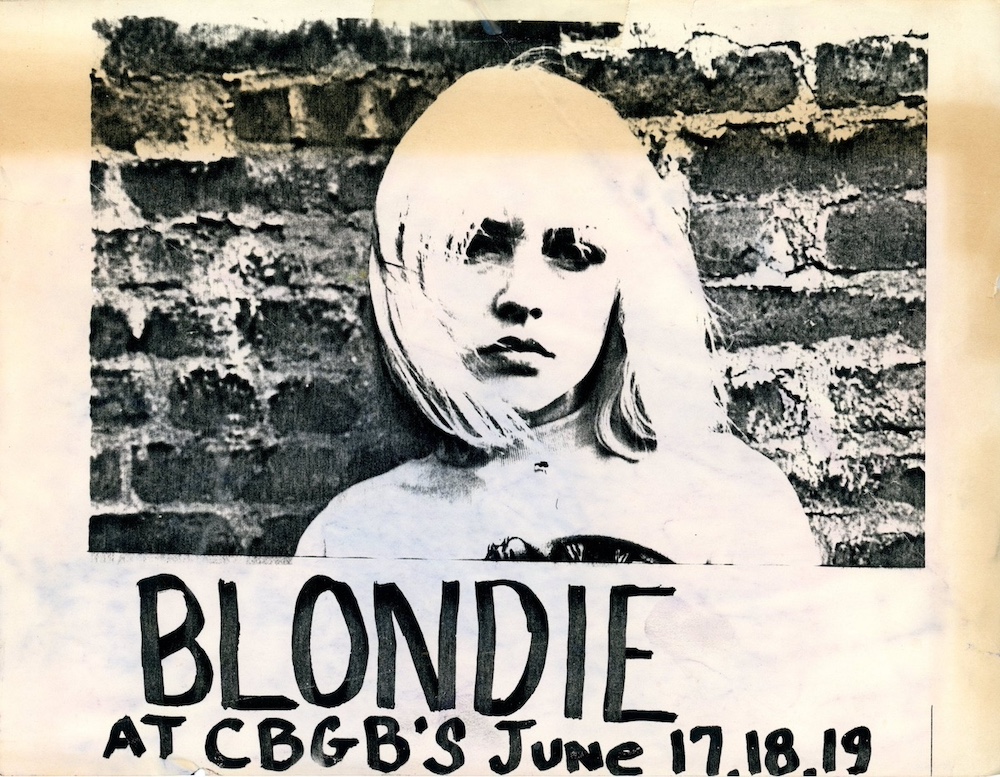CBGB’s, Blondie, Flyer, 1976. Courtesy online Gallery 98.
As the 1960s gave way to the ‘70s, a new generation of New York upstarts transformed the downtown nightlife scene forevermore with an inimitable blend of glamour, grit and DIY mythos. The arrival of Max’s Kansas City in Union Square signaled a change of guard; with Andy Warhol commanding the Back Room, a cast of characters from worlds of art, music, fashion, and film that were instant Superstars.
Soon enough clubs like CBGB, Mudd Club, Club 57, Paradise Garage, and Area appeared south of 14th Street, becoming the ultimate third space for creativity, community, and shenanigans alike. “It wasn’t unusual to be going to clubs, three, four nights a week,” says artist and archivist Marc H. Miller, who arrived in New York in 1968 and set up shop at 98 Bowery when it was the center of the city’s radical punk scene.

Miller worked as a conceptual artist, collaborating with Bettie Ringma on “Paparazzi Self-Portraits,” a 1975 series of Polaroid snapshots with Angela Davis, Susan Sontag, and William S. Burroughs. The following year, they embarked on “Bettie Visits CBGB,” bringing the camera to the favorite haunt for snaps with punk icons like Richard Hell, Patti Smith, the Dead Boys, Sable Starr and Nancy Spungen.
“When I first started going to CBGBs in the mid-70s, the scene was exploding,” says Miller. “Every night, there was three people on the on the bill, and you didn’t want to miss who might be breaking.” On any given night one might encounter Debbie Harry and Chris Stein of Blondie, filmmaker Amos Poe, photographer Jimmy DeSana, or Ramones’ art director Arturo Vega in the mix.

Decades before digital technology invaded every corner of our waking lives, the key to knowing what was going on was to be outside at all times. But where, when, and why? These were the questions club flyers answered with a nod and a smile. Artists, photographers, and graphic designers began to collaborate, making inexpensive DIY invitations that they could hand off to friends and local haunts, creating an aesthetic that readily lent itself to becoming a collectible.
Artists like Keith Haring, Antonio Lopez, Jenny Holzer, and David LaChapelle, understood that art in the age of mechanical reproduction was a revolutionary act, with the multiple becoming a signifier of community. Though mere slips of paper bearing designs produced en masse and distributed for free, the club flyer answered the age of questions, “Who’s going to be there?” As the decades passed, these flyers became increasingly valuable as they transformed into a part of the historical record without losing any of their original razzle dazzle.

While some people kept diaries and calendars, others like Miller kept track of the times by preserving the flyers themselves. “Anything that that struck my attention, I would throw them into boxes like Andy Warhol did with his time capsules,” he says. “A lot of my contemporaries did the same thing: throw cards into boxes and then throw the boxes into closets.”
But it wasn’t until Miller began building his artist website, 98 Bowery, that these objects’ second life as artifacts revealed themselves. Seeing a world of documentation that needed a visionary to embrace the chaos of analogue communiqués in a digital world, Miller created Gallery 98, perhaps the greatest repository of downtown 1970s and ‘80s ephemera. From club flyers and gallery announcement cards to magazines like the original Details, Night, and Project X, Miller has built an archive devoted to preserving this fabled chapter of New York history.

“By the mid-70s, there was a lot of crossover between the art and club scenes, especially amongst younger artists,” says Miller. “The trick was to get the flyers, because that was the way to get into the clubs for free. It was that simple.” Promoters and artists collaborated to create eye catching flyers they could spread by hand to advertise their one-night only affairs. Produced en masse and distributed by hand and at local shops, the nightclub flyers offered entrée into events happening that week, With the passage of time, most have disappeared save the few that managed to be preserved, elevating them to the provenance of art.
“This is really one of the last purely analog periods, and these things can be admired in terms of the history of printing and posters from the 1890s, to artists like Toulouse-Lautrec and Alphonse Mucha,” Miller says, pointing to work of advertising companies to hire the greatest painters of the age, their distinctive styles emblematic of a libertine age of art, music, nightlife, and parties in the years
leading up to a new century. History rhymes, as they say.





Follow Miss Rosen on Twitter


